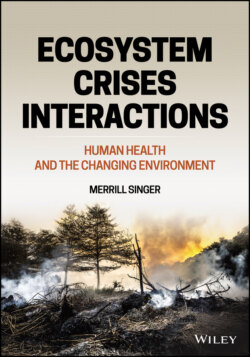Читать книгу Ecosystem Crises Interactions - Merrill Singer - Страница 14
1.3 Three alternative approaches to health and the environment
ОглавлениеThere is a wealth of evidence connecting ecosystem change with human and nonhuman health impacts. The following discussion of this relationship is organized around the examination of three holistic and interdisciplinary approaches to health: EcoHealth, One Health, and planetary health. All of these, rooted philosophically in wildlife ecologist Aldo Leopold’s (1949) concept of “land health”—the maintenance capacity of organisms and natural systems for internal self‐renewal—reflect an ecological turn that occurred in public health beginning in the 1980s. Deeper roots extend to early thinkers such as Calvin Schwabe (who worked with pastoralists in East Africa and coined the concept of “one medicine,” linking biomedicine and veterinary medicine) and Rudolf Virchow (who pointed to the role of the socioeconomic environment in the origins of infectious and other disease outbreaks), both of whom recognized the close relationship between the health of humans and work done in veterinary medicine (Zinsstag et al. 2010).
Expressing a holistic vision, these approaches seek to break down the historic compartmentalization that separated specialized understandings of the environment and specialized understandings in health. While their points of origin differ, “the relative synchrony of the success of [these] paradigms … did not come about purely by chance: they respond to a growing common perception of the complexity of the linkages between animal and human health and their proximate and distant socio‐ecological environment” (Roger et al. 2016). All three were influenced by the Ottawa Charter of 1986, which highlighted the centrality of ecosystems and sustainable resources for human health. They share: 1) a focus on environmental factors in health; 2) a recognition of the increasing interconnectedness of ecosystems in a globalizing world; and 3) the underlying assumption that humans and other animals face many of the same environmental challenges (e.g., infectious disease, food and nutrition, contention with weather). Roger et al. (2016) note that:
Despite their different origins, One Health and EcoHealth are convergent in their vision and goals to reposition animal and public health within their broader context. Both are motivated by the conviction that health concerns must be addressed at the human–animal interface within their broader natural and social environments (i.e., socio‐ecosystem approach). Both try to integrate scientific disciplines combining multi‐ and cross‐disciplinary approaches. Both aim to mitigate the risks threatening ecosystems and public health, including veterinary public health. Both deal with the complexity of diseases and health … Finally, both struggle to properly define the boundaries of their paradigms despite their apparent similarities regarding principles and objectives.
The Ottawa Charter was a product of the first International Conference on Health Promotion, which took place in Ottawa, Canada in November 1986. Its objective was to expedite the achievement of the U.N. goal of Health For All. A response to the growing expectations for a new public health movement around the world, signatories to the Charter recognized that a key requirement of health is having a supportive environment. While the primary focus was on the built or human‐created environment (e.g., cities and industrial workplaces), there was also a recognition of the need for a stable ecosystem and sustainable natural resources. Subsequent key events in the study of ecology and health included the Rio Declaration of 1992, which was a product of the U.N. Conference on Environment and Development, the launching of the journal EcoHealth in 2004, and the founding of the International Association for Ecology & Health (IAEH) in 2009. These developments have been described as representing a “transdisciplinary imperative for a sustainable future” (Wilcox et al. 2004).
Because of the similarities among them, some have urged a merging of these three alternative approaches to health promotion (Parkes 2012; Zinsstag et al. 2012; Roger et al. 2016). Despite their shared features, however, they are not synonymous. One critical factor that differentiates them is their handling of the human–animal–environment interface (see later). The effort to discuss and compare these approaches is complicated by the various definitions that exist for each of them. Following Lerner & Berg (2017), the focus here is on their respective core values.
